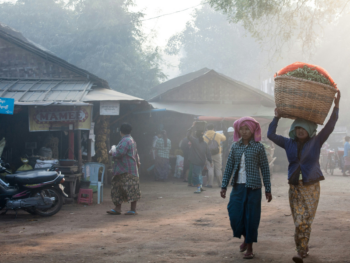According to U.N. research, roughly 2 million people in Myanmar are at risk of starvation in the coming months. A raging conflict between the military junta ruling the country and ethnoreligious resistance forces continues to wreak havoc across the country.
the coming months. A raging conflict between the military junta ruling the country and ethnoreligious resistance forces continues to wreak havoc across the country.
According to media sources, trade restrictions and international sanctions have exacerbated the disruption created by the conflict, already reducing some to eating rice bran — an agricultural byproduct usually used as animal feed. Some families interviewed by the U.N. have cut their food consumption to one meal a day or less.
The U.N. report comes weeks after Myanmar’s military junta strengthened relations with China, a longtime supporter of the junta along with Russia. Junta leader Min Aung Hlaing visited China earlier this month, and China came out in the weeks following to express support for the junta-controlled elections planned for next year.
Globally, these elections have been widely criticized as a shallow attempt to grant legitimacy to a military government that has relentlessly persecuted its people for decades and aggressively seized power in 2021.
Myanmar contains many distinct ethnic and religious groups. Though a strong majority of the population is ethnic Burman, and an even greater percentage is Buddhist, the communities that make up the remainder are well-established, well-organized, and, for the most part, predate the formation of the modern state by centuries.
In many cases, Burma’s ethnic minorities have taken on a distinct religious identity as well. About 20% to 30% of ethnic Karen are Christians, while other groups — such as the Chin — are more than 90% Christian. Rakhine state contains a large Muslim Rohingya population against whom the junta continues to wage genocide. This overlap of ethnic and religious identity has created a volatile situation for non-Buddhists across the country.
Despite support from Russia and China, the Tatmadaw is suffering from a series of battlefield setbacks stretching back to October 2023, when a coalition of ethnoreligious minorities from around the country launched a coordinated offensive against key military strongholds. In the year since, the coalition has wrested control of several key border towns from the military and killed or captured thousands of government soldiers, including high-ranking officers.
In August, the coalition captured the city of Lashio, a major regional hub for the Tatmadaw and home to its Northeastern Command. With this loss, the Tatmadaw is largely confined to the country’s center, surrounded by opposition forces to the West, North, and East.
Experts believe that Myanmar’s military is atrophying rapidly, with as few as 150,000 personnel remaining after the loss of tens of thousands of personnel through casualties or desertions since the 2021 coup. This number is significantly smaller than previous estimates of 300,000 to 400,000 and calls into question the junta’s ability to sustain its nationwide military campaign, especially after a series of high-profile losses in recent months.
In response to its shrinking ranks, the Myanmar government announced in February that it would begin a national conscription. According to an official announcement, the draft applies to all men aged 18 to 35 and all women aged 18 to 27 and can extend for up to five years.
Thousands of young people attempted to flee the country after the announcement, but many have been forced to join the military despite personal and moral objections to helping the Tatmadaw perpetuate the world’s longest ongoing civil war. — International Christian Concern






